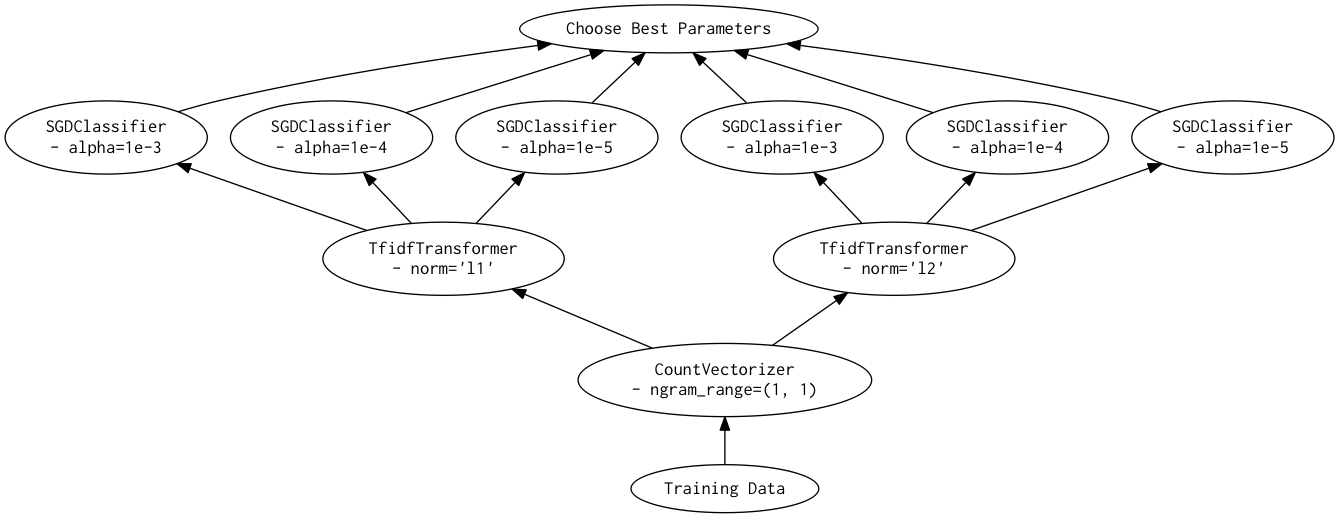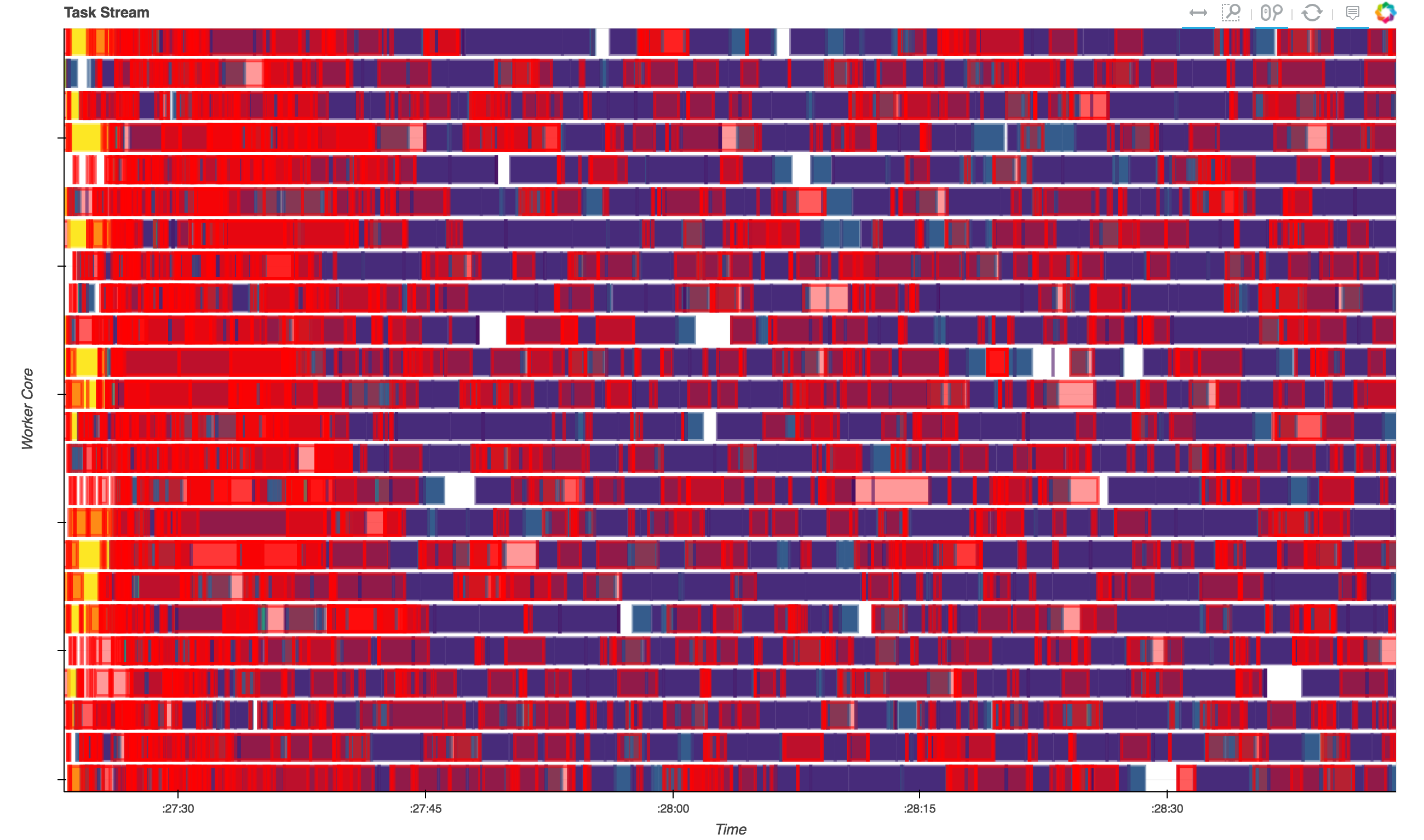Introducing Dask-SearchCV: Distributed hyperparameter optimization with Scikit-Learn
We introduce a new library for doing distributed hyperparameter optimization with Scikit-Learn estimators. We compare it to the existing Scikit-Learn implementations, and discuss when it may be useful compared to other approaches.
By Jim Crist, Continuum Analytics.
Introduction
Last summer I spent some time experimenting with combining dask and scikit-learn (chronicled in this series of blog posts). The library that work produced was extremely alpha, and nothing really came out of it. Recently I picked this work up again, and am happy to say that we now have something I can be happy with. This involved a few major changes:
- A sharp reduction in scope. The previous rendition tried to implement both model and data parallelism. Not being a machine-learning expert, the data parallelism was implemented in a less-than-rigorous manner. The scope is now pared back to just implementing hyperparameter searches (model parallelism), which is something we can do well.
- Optimized graph building. Turns out when people are given the option to run grid search across a cluster, they immediately want to scale up the grid size. At the cost of more complicated code, we can handle extremely large grids (e.g. 500,000 candidates now takes seconds for the graph to build, as opposed to minutes before). It should be noted that for grids this size, an active search may perform significantly better. Relevant issue: #29.
- Increased compatibility with Scikit-Learn. Now with only a few exceptions, the implementations of
GridSearchCVandRandomizedSearchCVshould be drop-ins for their scikit-learn counterparts.
All these changes have led to a name change (previously was dask-learn). The new library is dask-searchcv. It can be installed via conda or pip:
In this post I'll give a brief overview of the library, and touch on when you might want to use it over other options.
What's a grid search?
Many machine learning algorithms have hyperparameters which can be tuned to improve the performance of the resulting estimator. A grid search is one way of optimizing these parameters — it works by doing a parameter sweep across a cartesian product of a subset of these parameters (the "grid"), and then choosing the best resulting estimator. Since this is fitting many independent estimators across the same set of data, it can be fairly easily parallelized.
Example using Text Classification
We'll be reproducing this example. using the newsgroups dataset from the scikit-learn docs.
Setup
First we need to load the data:
Number of samples: 857
Next, we'll build a pipeline to do the feature extraction and classification. This is composed of aCountVectorizer, a TfidfTransformer, and a SGDClassifier.
All of these take several parameters. We'll only do a grid search across a few of them:
Number of candidates: 576
Fitting with Scikit-Learn
In Scikit-Learn, a grid search is performed using the GridSearchCV class, and can (optionally) be automatically parallelized using joblib. Here we'll parallelize across 8 processes (the number of cores on my machine).
CPU times: user 39.1 s, sys: 12.7 s, total: 51.8 s Wall time: 9min 12s
Fitting with Dask-SearchCV
The implementation of GridSearchCV in Dask-SearchCV is (almost) a drop-in replacement for the Scikit-Learn version. A few lesser used parameters aren't implemented, and there are a few new parameters as well. One of these is the scheduler parameter for specifying which daskscheduler to use. By default, if the global scheduler is set then it is used, and if the global scheduler is not set then the threaded scheduler is used.
In this case, we'll use the distributed scheduler setup locally with 8 processes, each with a single thread. We choose this setup because:
- We're working with python strings instead of numpy arrays, which means that the GIL is held for some of the tasks. This means we at least want to use a couple processes to get true parallelism (which excludes the threaded scheduler).
- For most graphs, the distributed scheduler will be more efficient than the multiprocessing scheduler, as it can be smarter about moving data between workers. Since a distributed scheduler is easy to setup locally (just create a
dask.distributed.Client()) there's not really a downside to using it when you want multiple processes.
Note the changes between using Scikit-Learn and Dask-SearchCV here are quite small:
<Client: scheduler='tcp://127.0.0.1:64485' processes=8 cores=8>
CPU times: user 36.9 s, sys: 9.75 s, total: 46.7 s Wall time: 7min 16s
Why is the dask version faster?
If you look at the times above, you'll note that the dask version was ~1.3X faster than the scikit-learn version. This is not because we have optimized any of the pieces of the Pipeline, or that there's a significant amount of overhead to joblib. The reason is simply that the dask version is doing less work.
Given a smaller grid
and the same pipeline as above, the Scikit-Learn version looks something like (simplified):
As a directed acyclic graph, this might look like:

In contrast, the dask version looks more like:
As a directed acyclic graph, this might look like:

Looking closely, you can see that the Scikit-Learn version ends up fitting earlier steps in the pipeline multiple times with the same parameters and data. Due to the increased flexibility of Dask over Joblib, we're able to merge these tasks in the graph and only perform the fit step once for any parameter/data/estimator combination. For pipelines that have relatively expensive early steps, this can be a big win when performing a grid search.
Distributed Grid Search
Since Dask decouples the scheduler from the graph specification, we can easily switch from running on a single machine to running on a cluster with a quick change in scheduler. Here I've setup a cluster of 3 m4.2xlarge instances for the workers (each with 8 single-threaded processes), and another instance for the scheduler. This was easy to do with a single command using the dask-ec2 utility:
To switch to using the cluster instead of running locally, we just instantiate a new client, and then rerun:
<Client: scheduler='tcp://54.146.59.240:8786' processes=24 cores=24>
CPU times: user 871 ms, sys: 23.3 ms, total: 894 ms Wall time: 2min 43s
Roughly a 3x speedup, which is what we'd expect given 3x more workers. By just switching out schedulers we were able to scale our grid search out across multiple workers for increased performance.
Below you can see the diagnostic plot for this run. These show the operations that each of 24 workers were doing over time. We can see that we're keeping the cluster fairly well saturated with work (blue) and not idle time (white). There's a fair bit of serialization (red), but the values being serialized are small, so this is relatively cheap to do. Note that this plot is also a bit misleading, as the red boxes are drawn on top of the running tasks, making it look worse than it really is.

Distributed Grid Search with Joblib
For comparison, we'll also run the Scikit-Learn grid search using joblib with the dask.distributed backend. This is also only a few lines changed:
CPU times: user 12.1 s, sys: 3.26 s, total: 15.3 s Wall time: 3min 32s
Analysis
In this post we performed 4 different grid searches over a pipeline:
| Library | Backend | Cores | Time | +----------------+--------------+-------+----------+ | Scikit-Learn | local | 8 | 9min 12s | | Dask-SearchCV | local | 8 | 7min 16s | | Scikit-Learn | distributed | 24 | 3min 32s | | Dask-SearchCV | distributed | 24 | 2min 43s |
Looking at these numbers we can see that both the Scikit-Learn and Dask-SearchCV implementations scale as more cores are added. However, the Dask-SearchCV implementation is faster in both cases because it's able to merge redundant calls to fit and can avoid unnecessary work. For this simple pipeline this saves only a minute or two, but for more expensive transformations or larger grids the savings may be substantial.
When is this useful?
- For single estimators (no
PipelineorFeatureUnion) Dask-SearchCV performs only a small constant factor faster than using Scikit-Learn with thedask.distributedbackend. The benefits of using Dask-SearchCV in these cases will be minimal. - If the model contains meta estimators (
PipelineorFeatureUnion) then you may start seeing performance benefits, especially if early steps in the pipeline are relatively expensive. - If the data your're fitting on is already on a cluster, then Dask-SearchCV will (currently) be more efficient, as it works nicely with remote data. You can pass dask arrays, dataframes or delayed objects to
fit, and everything will work fine without having to bring the data back locally. - If your data is too large for Scikit-Learn to work nicely, then this library won't help you. This is just for scheduling Scikit-Learn estimator fits in an intelligent way on small-medium data. It doesn't reimplement any of the algorithms found in Scikit-Learn to scale to larger datasets.
Future work
Currently we just mirror the Scikit-Learn classes GridSearchCV and RandomizedSearchCV for doing passive searches through a parameter space. While we can handle very large grids at some point switching to an active search method might be best. Something like this could be built up using the asynchronous methods in dask.distributed, and I think would be fun to work on. If you have knowledge in this domain, please weigh in on the related issue.
This work is supported by Continuum Analytics, the XDATA program, and the Data Driven Discovery Initiative from the Moore Foundation. Thanks also to Matthew Rocklin and Will Warner for feedback on drafts of this post.
Bio: Jim Crist holds a Bachelors and a (tentative) Masters in Mechanical Engineering from the University of Minnesota. Whilst procrastinating on his thesis, he got involved in the scientific Python community. He is currently a software developer at Continuum Analytics.
Original. Reposted with permission.
Related:
